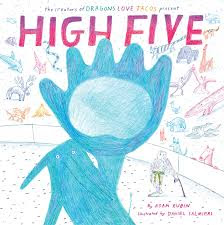Categories: roll the dice or draw a card with a color and the student picks a square from that row and teams can come up with examples, pairs of students, or individuals or even the whole class can write or draw them.
Another alternative way to play is to pick a category that goes with a book you will be reading & use the Name 5 as a concept formation tool.
Rock, Paper, Scissors tournament: did you know that the game has been around longer than the pyramids? That's a fun-fact shared by author Drew Daywalt in his read-aloud video of The Legend of Rock, Paper, Scissors.
It is easy to do a class tournament which is in-person. Pair students up, they play best out of 3 rounds and the winner gets paired up with another until there is one champion. There are variations on this, like, the loser of the rounds sits down or they follow their opponent who beat them and cheer them on. This is the slide I used with my second graders and a video of our first round of playing. The second round went much better!
In a virtual environment there are also variations. You can send partners into breakout rooms and then narrow it down from there. Or you can pair opponents up and all stay in the same room. For example, when I did this with 2nd graders I called the pairs out and made sure that they knew whose square to be focused on during the match. The winner of the round keeps their camera on. At the end of the round I re-paired them up for the next round, etc. For the last round we all turned our cameras on and cheered them on.
High Five tournament: Adam Rubin and Daniel Salmieri's picture book, High Five is especially fun to read before this activity.

The book trailer previews some variations on the style of high fiving:
After watching you can ask students which ones they liked the most, which ones were the hardest, etc. You can even have them recreate them and then choose one action to add on top of it. Students can work on these alone or individually and share them on a Flipgrid and have students vote for their favorites. You can also have a tournament in your class with students competing and some acting as judges, like in the book.
Here are our kindergarteners following the directions for a partner high five challenge:
This was the list that we practiced a few moves at a time. With older groups you can go through the motions and see who can perform them without looking at the list of directions:
Mannequin Challenge: Back in 2016 there was a viral video challenge that asked people to hold a pose while the camera spans the room. You can do this with students by choosing a prompt, asking them to hold a pose that they interpret as a good response and either video tape them OR take photos. Here is a clip of first graders holding a power pose:
We did this for Children's Book Week 2021 because the slogan was Reading is a Superpower. We replicated the girl in the center of the poster designed by illustrator Bryan Collier:
Students shared their superpower poses and we copied classmates. I turned their photos into a collage to share with families.
Beautiful Oops game:
Read aloud (or show a video read aloud of the book) Beautiful Oops! by Barney Saltzberg & challenge your students to take one of the mistakes in the and show an example of it:
- A spill
- Bent paper
- A drip of paint
- A scrap of paper
- A smudge & smear
- A stain
- Holes
- A wad
After they have made an example of a mistake they can put them all out on a table. Pull students' names, one-by-one, and have them choose one of the mistakes to turn into something else, like in the book.
This is fun because it builds community, students love thinking about their connections to one another and this is one way to create that bond. It's also enjoyable because they are all based on mistakes. They won't be perfect and that is the whole point. Students can be creative and if they are stuck they can use the book as a mentor text.
Finally, you can display the art and do a gallery walk with others in the school & see if they can spot the "mistake" that inspired the art!
You can even award a "Best in Show" and give them the follow-up book to Beautiful Oops!: My Book of Beautiful Oops! an interactive journal for young artists!
The book's website has more ideas on how to use the book and join the world-wide community sharing their Beautiful Oops on social media:












.jpg)
.jpg)




No comments:
Post a Comment